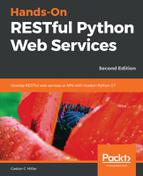Book Description
Explore the best tools and techniques to create lightweight, maintainable, and scalable Python web services
Key Features
- Combine Python with different data sources to build complex RESTful APIs from scratch
- Configure and fine-tune your APIs using the best tools and techniques available
- Use command-line and GUI tools to test CRUD operations performed by RESTful Web Services or APIs
Book Description
Python is the language of choice for millions of developers worldwide that builds great web services in RESTful architecture. This second edition of Hands-On RESTful Python Web Services will cover the best tools you can use to build engaging web services.
This book shows you how to develop RESTful APIs using the most popular Python frameworks and all the necessary stacks with Python, combined with related libraries and tools. You'll learn to incorporate all new features of Python 3.7, Flask 1.0.2, Django 2.1, Tornado 5.1, and also a new framework, Pyramid. As you advance through the chapters, you will get to grips with each of these frameworks to build various web services, and be shown use cases and best practices covering when to use a particular framework.
You'll then successfully develop RESTful APIs with all frameworks and understand how each framework processes HTTP requests and routes URLs. You'll also discover best practices for validation, serialization, and deserialization. In the concluding chapters, you will take advantage of specific features available in certain frameworks such as integrated ORMs, built-in authorization and authentication, and work with asynchronous code. At the end of each framework, you will write tests for RESTful APIs and improve code coverage.
By the end of the book, you will have gained a deep understanding of the stacks needed to build RESTful web services.
What you will learn
- Select the most appropriate framework based on requirements
- Develop complex RESTful APIs from scratch using Python
- Use requests handlers, URL patterns, serialization, and validations
- Add authentication, authorization, and interaction with ORMs and databases
- Debug, test, and improve RESTful APIs with four frameworks
- Design RESTful APIs with frameworks and create automated tests
Who this book is for
This book is for web developers who have a working knowledge of Python and would like to build amazing web services by taking advantage of the various frameworks of Python. You should have some knowledge of RESTful APIs.
